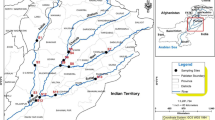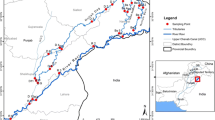Abstract
Cairo city is the largest populated area along the whole course of River Nile with a wide range of anthropogenic activities. Efforts to restore fish habitat and recreational use of the river have raised concerns about its water, sediment and biota quality. This study provides a baseline data on the levels of PCBs and trace metals in River Nile along Cairo sector and implements the formulation of monitoring activities of the river’s pollution status. Water, sediment and Nile tilapia (Oreochromis niloticus) samples were collected during summer season, 2013 from two sites, up- and downstream, for detection and determination of 11 PCB congeners (PCBs 28, 44, 52, 70, 101, 105, 118, 138, 152, 180 and 192) as well as six trace metals (Cu, Zn, Mn, Cd, Pb and Fe). Evidences of long- or short-term exposures to these contaminants as well as its accumulation tendency were assessed by integrating the obtained analytical results of biotic and abiotic components of this aquatic ecosystem. All calculated lifetime cancer risk values for PCBs showed unacceptable risk of cancer for human consumers at both normal and subsistence fish consumption rates. The calculated hazard index for total PCBs indicates that fish are not safe for human consumption except in site 1 at normal consumption rate. Meanwhile, trace metals do not pose unacceptable risks at both consumption rates except for Pb in site 1 at subsistence consumption rate.

Similar content being viewed by others
References
Amaraneni, S. R., & Pillala, R. R. (2001). Concentrations of pesticide residues in tissues of fish from Kolleru Lake in India. Environmental Toxicology, 16(6), 550–556. doi:10.1002/tox.10016.
Anderson, D. P., & Zeeman, M. G. (1995). Immunotoxicology in fish. In G. M. Rand (Ed.), Fundamentals of aquatic toxicology: Effects, environmental fate, and risk assessment (Vol. 2, pp. 371–404). London: Taylor and Francis.
APHA (American Public Health Association). (2005). Standard methods for the examination of water and wastewater. New York: American Water Works Association.
ATSDR (Agency for Toxic Substances and Disease Registry). (2000). Toxicological profile for polychlorinated biphenyls (PCBs). Atlanta: US Department of Health and Human Services, Public Health Service. http://www.atsdr.cdc.gov/toxprofiles/tp17.pdf.
Barton, B. A., Morgan, J. D., & Vijayan, M. M. (2002). Physiological and condition-related indicators of environmental stress in fish. In S. M. Adams (Ed.), Biological indicators of aquatic ecosystem stress (pp. 111–148). Bethesda: American Fisheries Society.
Biswas, S., Prabhu, R. K., Hussain, K. J., Selvanayagam, M., & Satpathy, K. K. (2012). Heavy metals concentration in edible fishes from coastal region of Kalpakkam, southeastern part of India. Environmental Monitoring and Assessment, 184, 5097–5104. doi:10.1007/s10661-011-2325-y.
Cohrssen, J. J., & Covello, V. T. (1989). Risk analysis: A guide to principles and methods for analyzing health and environmental risks. Washington, DC: Executive Office of the President of the United States, Council on Environmental Quality.
Copat, C., Bella, F., Castaing, M., Fallico, R., Sciacca, S., & Ferrante, M. (2012). Heavy metals concentrations in fish from Sicily (Mediterranean Sea) and evaluation of possible health risks to consumers. Bulletin of Environment Contamination and Toxicology, 88, 78–83. doi:10.1007/s00128-011-0433-6.
Demirak, A. F., Yilmaz, A. L., Ozdemir, T., & Ozdemir, N. (2006). Heavy metals in water, sediment and tissues of Leuciscus cephalus from a stream in southwestern Turkey. Chemosphere, 63, 1451–1458. doi:10.1016/j.chemosphere.2005.09.033.
Ebrahimpour, M., & Mushrifah, I. (2010). Seasonal variation of cadmium, copper, and lead concentrations in fish from a freshwater lake. Biological Trace Element Research, 138, 190–201. doi:10.1007/s12011-009-8596-2.
FAO (Food and Agriculture Organization of the United Nations). (2010a). Fisheries and aquaculture information statistics service. http://www.fao.org/docrep/013/i1890t/i1890t.pdf.
FAO (Food and Agriculture Organization of the United Nations). (2010b). Fishery and aquaculture country profiles, Egypt. Country profile fact sheets. Rome: FAO Fisheries and Aquaculture Department. http://www.fao.org/fishery/countrysector/naso_egypt/en. Accessed August 29 2013.
Hansen, L. G. (1999). The ortho side of PCBs: Occurrence and Disposition. Boston: Kluwer Academic Publishers.
Has-Schon, E., Bogut, I., & Strelec, I. (2006). Heavy metal profile in five fish species included in human diet, domiciled in the end flow of River Neretva (Croatia). Archives of Environmental Contamination and Toxicology, 50(4), 545–551. doi:10.1007/s00244-005-0047-2.
Hopper, M. L., & King, J. W. (1991). Enhanced supercritical fluid carbon dioxide extraction of pesticides from foods using pelletized diatomaceous earth. Journal-Association of Official Analytical Chemists, 74(4), 661–666.
Hseu, Z. Y. (2004). Evaluating heavy metal contents in nine composts using four digestion methods. Bioresource Technology, 95, 53–59. doi:10.1016/j.biortech.2004.02.008.
Issac, R. A., & Kerber, J. D. (1971). Atomic absorption and flame photometry. Techniques and uses in soil, plant and water analysis. In L. M. Walsh (Ed.), Instrumental methods for analysis of soil and plant tissue (pp. 17–37). Madison, WI: Soil Science Society of America-Agronomy Society of America, Inc.
Jabeen, F., & Chaudhry, A. S. (2010). Environmental impacts of anthropogenic activities on the mineral uptake in Oreochromis mossambicus from Indus River in Pakistan. Environmental Monitoring and Assessment, 166, 641–651. doi:10.1007/s10661-009-1029-z.
Kiviranta, H., Ovaskainen, M. L., & Vartiainen, T. (2004). Market basket study on dietary intake of PCDD/Fs, PCBs, and PBDEs in Finland. Environment International, 30, 923–932. doi:10.1016/j.envint.2004.03.002.
Linde-Arias, R. A., Inácio, F. A., de Alburquerque, C., Freire, M. M., & Moreira, C. J. (2008). Biomarkers in an invasive fish species, Oreochromis niloticus, to assess the effects of pollution in a highly degraded Brazilian River. Science of the Total Environment, 399, 186–192. doi:10.1016/j.scitotenv.2008.03.028.
Loganathan, B. G., & Kannan, K. (1994). Global organochlorine contamination trends: An overview. Ambio, 23(3), 187–191.
Maceda-Veiga, A., Green, A. J., & De Sostoa, A. (2014). Scaled body-mass index shows how habitat quality influences the condition of four fish taxa in north-eastern Spain and provides a novel indicator of ecosystem health. Freshwater Biology, 59, 1145–1160. doi:10.1111/fwb.12336.
Malik, N., Biswas, A. K., Qureshi, T. A., Borana, K., & Virha, R. (2010). Bioaccumulation of heavy metals in fish tissues of a freshwater lake of Bhopal. Environmental Monitoring and Assessment, 160, 267–276. doi:10.1007/s10661-008-0693-8.
Mansour, S. A. (2008). Environmental impact of pesticides in Egypt. In D. M.Whitacre (Ed.), Reviews of environmental contamination and toxicology, (vol 196). Springer Science and Business Media, LLC, (pp 1–51). doi:10.1007/978-0-387-78444-1_1.
McNeil, D. G., & Fredberg, J. (2011). Environmental water requirements of native fishes in the Middle River catchment, Kangaroo Island, South Australia. A report to the SA Department for Water. South Australian Research and Development Institute (Aquatic Sciences), Adelaide. SARDI Publication no. f2011/000060-1. Sardi Research Report Series, 528, 1–50.
Mills, S. A., Thal, D. I., & Barney, J. (2007). A summary of the 209 PCB congener nomenclature. Chemosphere, 68(9), 1603–1612. doi:10.1016/j.chemosphere.2007.03.052.
Mohammadi, M., Sary, A. A., & Khodadadi, M. (2011). Determination of heavy metals in two barbs, Barbus grypus and Barbus xanthopterus in Karoon and Dez Rivers, Khoozestan, Iran. Bulletin Environmental Contamination Toxicology, 87, 158–162. doi:10.1007/s00128-011-0302-3.
Muir, D., & Sverko, E. (2006). Analytical methods for PCBs and organochlorine pesticides in environmental monitoring and surveillance: A critical appraisal. Analytical and Bioanalytical Chemistry, 386, 769–789. doi:10.1007/s00216-006-0765-y.
Omar, W. A., Zaghloul, K. H., Abdel-Khalek, A. A., & Abo-Hegab, S. (2012). Genotoxic effects of metal pollution in two fish species, Oreochromis niloticus and Mugil cephalus, from highly degraded aquatic habitats. Mutation Research, 746, 7–14. doi:10.1016/j.mrgentox.2012.01.013.
Omar, W. A., Zaghloul, K. H., Abdel-Khalek, A. A., & Abo-Hegab, S. (2013). Risk assessment and toxic effects of metal pollution in two cultured and wild fish species from highly degraded aquatic habitats. Archives of Environmental Contamination and Toxicology, 65, 753–764. doi:10.1007/s00244-013-9935-z.
Ostrander, G. K. (1996). Techniques in aquatic toxicology (p. 185). New York: Lewis Publishers.
Peig, J., & Green, A. J. (2009). New perspectives for estimating body condition from mass/length data: The scaled mass index as an alternative method. Oikos, 118, 1883–1891. doi:10.1111/j.1600-0706.2009.17643.x.
Sabry, S. (2009). Poverty lines in Greater Cairo: Underestimating and misrepresenting poverty. Human settlements working paper series: Poverty reduction in urban Areas, working paper 21. London: International Institute for Environment and Development (IIED). http://www.iied.org/pubs/display.php?o=10572IIED.
SAS (Statistical Analysis System). (2006). SAS/STAT user’s guide,(version 9.1). Cary, NC: SAS.
Schreck, C. B., & Moyle, P. B. (1990). Methods for fish biology. Bethesda: American Fisheries Society.
Shinn, C. A., Dauba, F., Grenouillet, G., Guenard, G., & Lek, S. (2009). Temporal variation of heavy metal contamination in fish of the river lot in southern France. Ecotoxicology and Environmental Safety, 72, 1957–1965. doi:10.1016/j.ecoenv.2009.06.007.
Srogi, K. (2008). Levels and congener distributions of PCDDs, PCDFs and dioxin-like PCBs in environmental and human samples: A review. Environmental Chemistry Letters, 6, 1–28. doi:10.1007/s10311-007-0105-2.
Tekin-Özan, S. (2008). Determination of heavy metal levels in water, sediment and tissues of tench (Tinca tinca L., 1758) from Beysehir Lake (Turkey). Environmental Monitoring and Assessment, 145, 295–302. doi:10.1007/s10661-007-0038-z.
USEPA (United States Environmental Protection Agency). (1996). Method 3620C, Florisil cleanup. http://www.epa.gov/SW-846/pdfs/3620c.pdf.
USEPA (United States Environmental Protection Agency). (2000). Guidance for assessing chemical contaminant data for use in fish advisories. In Risk assessment and fish consumption limits (Vol 2, 3rd ed). Washington, DC: Office of Science and Technology and Office of Water. (EPA/823/B-97/009).
USEPA (United States Environmental Protection Agency). (2003). Non-dioxin-like PCBs: Effects and consideration in ecological risk assessment. Experimental Toxicology Division, National Health and Environmental Effects Research Laboratory, Office of Research and Development (NCEA-C- 1340, ERASC-003). http://www.epa.gov/oswer/riskassessment/pdf/1340-erasc-003.pdf.
USEPA (United States Environmental Protection Agency). (2009a). Polychlorinated biphenyls (PCBs) (CASRN 1336-36-3). Toxicity and exposure assessment for children’s health (TEACH) chemical summary. http://www.epa.gov/teach/chem_summ/PCB_summary100809.pdf.
USEPA (United States Environmental Protection Agency). (2009b). National primary drinking water regulations. List of contaminants and their maximum contaminant levels (MCLs). EPA 816-F-09-0004. http://water.epa.gov/drink/contaminants/upload/mcl-2.pdf.
USEPA (United States Environmental Protection Agency). (2015). Human health risk assessment, risk-based screening table, regional screening level (RSL) summary table.http://semspub.epa.gov/work/03/2218434.pdf.
Usero, J., Regalado, E. G., & Gracia, I. (1997). Trace metals in bivalve molluscs Ruditapes decussatus and Ruditapes philippinarum from the Atlantic coast of southern Spain. Environment International, 23, 291–298. doi:10.1016/S0160-4120(97)00030-5.
Van den Berg, M., Birnbaum, L., Bosveld, A. T. C., Brunstrom, B., Cook, P., Freeley, M., et al. (1998). Toxic equivalency factors (TEFs) for PCBs, PCDDs, PCDFs for humans and wildlife. Environmental Health Perspectives, 106, 775–792.
Wahaab, R. A., & Badawy, M. I. (2004). Water quality assessment of the River Nile system: An overview. Biomedical and Environmental Sciences, 17, 87–100.
Walker, C. H. (2009). Organic pollutants: An ecotoxicological perspective (2nd ed.). New York: CRC Press, Taylor and Francis Group.
Weatherley, A. H., & Gill, H. S. (1987). The biology of fish growth (pp. 147–173). London: Academic Press.
Wells, D. E., & Hess, P. (2000a). Separation, clean-up and recoveries of persistent trace organic contaminants from soils, sediment and biological matrices. In E. Barceló (Ed.), Sample handling and trace analysis of pollutants, techniques, applications and quality assurance (pp. 73–116). Amsterdam: Elsevier.
Wells, D. E., & Hess, P. (2000b). Determination and evaluation of chlorinated biphenyls. In E. Barceló (Ed.), Sample handling and trace analysis of pollutants, techniques, applications and quality assurance (pp. 239–285). Amsterdam: Elsevier.
WHO (World Health Organization). (1988). Chlordane: Health and safety guide. Geneva: International programme on chemical safety.
WHO (World Health Organization). (2008). Guidelines for drinking-water quality (3rd ed., Vol. 1). Geneva: WHO.
WHO (World Health Organization). (2011). Evaluation of certain food additives and contaminants: Seventy-third report of the joint FAO/WHO expert committee on food additives. WHO technical report series 960. http://whqlibdoc.who.int/trs/WHO_TRS_960_eng.pdf.
Acknowledgments
The authors would like to gratefully acknowledge Professor Dr Islam Noman Nasr, Department of Pesticide Residues and Environmental Pollution, Central Agricultural Pesticide Laboratory, Agriculture Research Center, Egypt, for his technical support and experimental help in quantitative determination of PCBs.
Author information
Authors and Affiliations
Corresponding author
Ethics declarations
Conflict of interest
The authors declare that they have no conflict of interest.
Rights and permissions
About this article
Cite this article
Omar, W.A., Mahmoud, H.M. Risk assessment of polychlorinated biphenyls (PCBs) and trace metals in River Nile up- and downstream of a densely populated area. Environ Geochem Health 39, 125–137 (2017). https://doi.org/10.1007/s10653-016-9814-4
Received:
Accepted:
Published:
Issue Date:
DOI: https://doi.org/10.1007/s10653-016-9814-4




